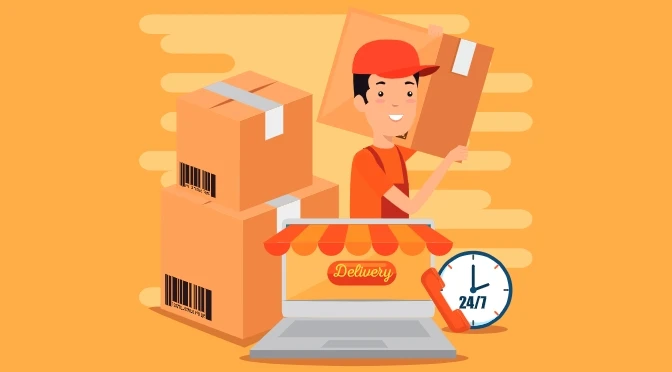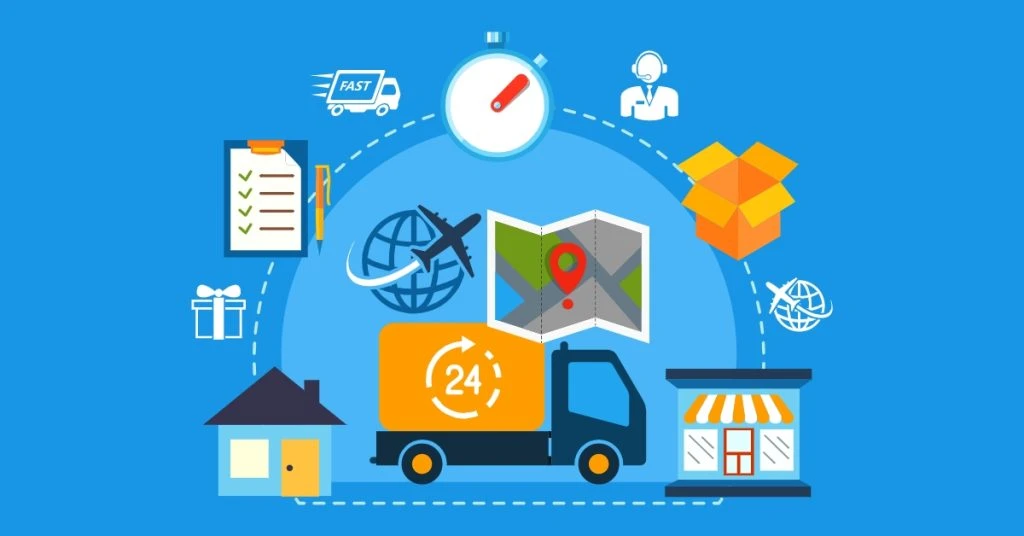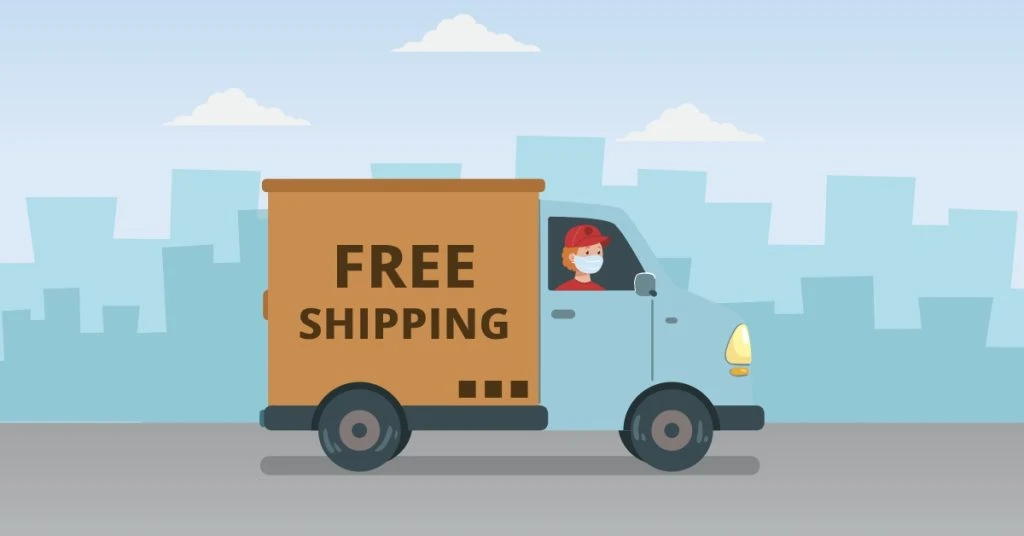Best eCommerce Shipping (Product Delivery) Solutions with Examples

Efficient shipping policy is one of the most important strategies a company can adopt to grow your online ecommerce business.
Many brands start their businesses in this domain by adopting a simplistic approach to the shipping method. By offering free shipping services across the milieu of services or exhibit unmodified postal service rates, most of the merchants successful in their businesses use several options for shipping. This strategy can help them to gain a competitive advantage in the same sphere of activity and increase their profit margins significantly.
Since having a better framework for shipping can help the companies gain a competitive advantage in the economy, it is vital to ensure that the company can adhere to the shipping strategy that has been framed.
This process of implementation can be achieved only when the teams within the organization act in a very coordinated manner. All the teams – starting from manufacturing and marketing to the fulfillment team can be coordinated in a way that can result in the strategy being implemented in the ecommerce business to create a proper supply chain network.
Implementing a proper shipping strategy for your online business facilitates effective communication between one part of the company to another. It helps all the stakeholders in the business to be aware of the processes going on in their business and the roles that they need to play.
This guide towards adopting the best ecommerce policies and solutions and implementing them ensures that you become aware of the necessary information required to plan and implement a very structured ecommerce policy. Such a strategy can help to provide a substantial profit margin that can satisfy the demands of the business, as well as its customers.

Before we proceed, it is essential to know what the ‘eCommerce shipping’ terminology refers to.
Ecommerce shipping definition
Any service that is required to transport the products or solutions purchased from an ecommerce retailer to the destination mentioned by the customer is referred to as ecommerce shipping. With the help of the perfect shipping partner for your business, this process can be streamlined to make it faster, manageable, and affordable.
Some methods and strategies in ecommerce shipping
Every one of the eCommerce shipping strategies has to be customized for each of the company’s sectors. Selecting the right eCommerce strategies will depend on understanding the audience for the business, the products, and the price margins, along with several other factors.
Shipping processes for the items sold online.
1. An online sale is recorded
2. Select the products to be packaged and determine their weight and size
3. Confirm the destination of the shipment
4. Find out which shipping carrier would be the best for your business and generate the shipping costs for the same
5. Dispatch the packages via the best courier shipping option available.
The key to selecting the best strategy is by offering a combination of shipping methods that are both fast and affordable, which can result in lesser cases of shopping cart abandonment by the customers. This method can also increase the number of order conversions.
Below are some of the shipping methods that you can consider as a part of your business strategy for e-commerce shipping.
1. Same-day shipping
This mode of delivery ensures that your orders will be dispatched and delivered on the same day that it is placed from the website. Sometimes, due to some urgent requirement for an article, the customer can opt for such a form of expedited delivery. Studies show that 61% of the customers will be willing to spend more money to deliver their orders within a day.
Even then, this kind of delivery usually requires a considerable amount of coordination between the different resources, technology, and courier services.
2. Two-day shipping
Due to the industry’s giant players, such as Amazon Prime, online shopping has become synonymous with the two-day shipping method. Although implementing such a framework for smaller ecommerce companies seems like a difficult task for a lot of the businesses. Still, plans exist to facilitate the same for these businesses without creating a hole in the company’s pocket.
3. Expedited shipping
This method of shipping is usually used in any other form of transportation that delivers faster than standard ground shipping methods. The turnaround times for this method of shipping is typically subject to variation depending on the shipping and carrier services chosen by the business. The businesses which provide this kind of expedited shipping result in lesser shopping cart abandonment, fulfilling customer expectations, and building a long-term relationship with the buyer.
4. Overnight shipping
This form of a shipping method ensures that the customer will receive the delivery of the goods on the next business day. This method helps to differentiate between brands in an industry where two-day shipping is the standard method of conducting business. The prices of this kind of shipping method can vary from one shipping service provider to another.
5. International shipping
Whether the company handles its operations locally or has a multinational presence, implementing international shipping services is a challenge that any business in the industry can face. The primary problem in this kind of a shipping process is that the shipping prices can vary widely depending on the country the product is being shipped to and the country’s exchange rates.
Hence, providing this kind of shipping mechanism is often expensive for the company. Moreover, different countries are governed by different laws, have different requirements for shipments entering the states, and are subject to separate tariffs and taxes.
Such problems make it extremely important for these businesses to look for fulfillment partners who have sufficient experience in the shipping sector. These partners will help you figure out the perfect solution for your company concerning international shipping and offer affordable shipping charges.
6. Freight Shipping
Freight shipping usually refers to cargo shipment across the world using air, land, or sea transportation. A shipment weighing over 150 pounds or has a dimension larger than 30-inch x 30-inch x 30-inch is referred to as freight. The ecommerce businesses use this type of shipping to build up their inventory by receiving shipments from their manufacturers and sending them to their regional fulfillment centers and distributors.
Some Best Practices in the Realm of Ecommerce Shipping

- Assembling the right team for the task: Since all the departments of the organization play a role in facilitating efficient shipping methods for your online store.
- Setting specific goals: Whether it is to increase profits, venture into newer markets, or go international, it should be structured and defined transparently.
- Choosing a shipping strategy that is perfect for your business: From the different options for shipping that are available, you need to choose the best one that fits your business goals
- Trying out the strategies: Only selecting a plan that is best for the business is enough. It is crucial to implement the strategy and root out the inefficiencies in the supply chain.
Now let us understand the above best practices in detail.
1. Assembling the right team:
The first step of this process is to ensure that you identify the right people who can assist you in making this kind of decision. This step requires you to determine the stakeholders in the daily operations of the business and their roles. Each of the functions and the stakeholders under them needs to work harmoniously. Some of them are mentioned below:
Marketing: This team is involved in the communication and the promotion of your shipping methods to the customers and use this as an incentive to attract potential buyers to your ecommerce platform. Delivery incentives such as free shipping or flat-rate shipping can increase order value and draw more traffic to your site.
This team should be able to answer questions regarding profitably hosting promotional offers, decreasing the rate of cart abandonment, festival seasons and seasonal offers that can be promoted, and much more.
Web Development Team: This team is mainly in charge of showing the right shipping options to the buyer at the right time so that the offers (both seasonal and non-seasonal) are visible to the customers.
This team is in charge of providing information about which is the customer’s preferred mode of shipping, the offers that might be more appealing to them, the primary cost drivers, results of A/B testing, and which offers are preferred more as compared to the others.
Order Fulfilment: This team’s primary role is to ensure the appropriate packaging and shipping of the orders depending on the kind of delivery option chosen by the customer. Whatever any of these options might entail, this team should be able to fulfill the order.
This team needs to be well-versed in the number of shipping options available to the customers, knowledge of the company’s agreements with the different shipping service providers, marking and labeling methods adopted by the company, etc.
Customer Service: This team uses the data regarding the company’s approach to the shipping methods and how it affects the customer at each level of the delivery process to answer the queries of the buyers or assist them with any issues they face.
This team is expected to be well-versed with the different shipping options available under the different price points and should be able to tackle such questions when they encounter something like that. Besides this, this team is in charge of dealing with disgruntled customers if they face any problems or delays in shipping.
All the above teams need to work in harmony to ensure an efficient ecommerce process and thus have to be assembled very carefully.
2. Defining the goals for your shipping strategy
Once your company is done identifying the key teams and selecting their members, the next step would be to ascertain what needs to be accomplished using the ecommerce shipping policies of your business.
Although there can be a lot of avenues that can be the focus of such businesses, the most typical ones are mentioned below:
· Increasing the number of conversions
· Increasing the average value of the orders placed
· Expanding into newer markets or targeting a broader audience
· Lower costs
· Improving supply chain efficiency
Increasing the number of conversions: This can be facilitated by offering shipping options and rates of shipping, which are not so high that the customer would not be able to afford it. The shipping charges have a significant impact on the frequency of placement of orders as well as the rate of order conversion.

One way of facilitating this can be through the use of A/B testing methods for the various shipping options, promotions, and rates available to determine which ones have the highest standard of conversion. Another technique that can be adopted is using heat maps to understand how the site might look for the customer.
Increasing the Average Order Value (AOV)
The AOV can be increased by implementing promotional offers that encourage the buyers to spend more. Usually, this method involves setting the free shipping threshold at a level that would support the buyer to purchase a more significant number of goods than they would have initially.
This process can be facilitated by sending personalized notifications to the customers who would only need to spend a bit more to qualify for availing free shipping. Other ways to promote the same can be to recommend products that can increase the AOV to grab the shopper’s attention while they are checking out.
Expanding into newer markets or targeting a more extensive audience
This expansion can be encouraged through offering to ship the products to newer geographical areas where your company was previously not shipping to.
The easiest way to do this would be to offer international shipping options or other alternatives such as local delivery or in-store pick-up of goods that can help extend the business’s reach. Another way to go about this would be to work with the marketing team to promote the newer service offerings to these new customer categories using social media and search engine promotions.
Lower costs
The method of facilitating this can be through making incremental changes to the process of fulfillment as well as the shipping charges that the brand offers. The most prominent players in this industry, such as FedEx and UPS, provide services such as FedEx SmartPost and UPS SurePost that can decrease the costs monumentally besides delivering assurance for a high level of service.
This decrease in costs can be facilitated by using a real-time rate calculator and ensuring a good relationship with the shipping partner. Another way to implement this decrease in the expenses is by bringing in additional in-house manufacturing to a single facility to lower the extra costs from manufacturing products. Such a measure can also help in increasing the margins while incurring flat-rate shipping costs.
Improving supply chain efficiency
Such a measure helps ensure that the communication within the supply chain is maintained so that the company can make more informed decisions regarding picking, packing, and shipping the orders.
Increasing supply chain efficiency can be facilitated by including line items like purchasing new packages or using other services such as ShipStation or going through the fulfillment process to ensure that the supply chain inefficiencies can be rooted out. This process can be repeated across the different teams to ensure that the new shipping orders can be completed through a predefined schedule, from marketing to fulfillment.
Selecting the perfect ecommerce shipping options and solutions

After identifying the goals for your business and choosing the best team to carry out the purposes, the next task is to identify the best strategy that will help your organization accomplish the goals that have been set.
Before implementing and executing the strategies, it is necessary to identify the pros and cons of each of them. It is required to understand that none of these strategies are mutually exclusive. Any successful online store will have to combine several of these options to come up with a proper plan for every unique scenario.
Firstly, as the ecommerce manager in charge of managing and implementing the shipping strategies, you have to start with having a clear understanding of how the ecommerce business works.
Some of the crucial considerations that need to be taken into account:
Several studies conducted in the field of ecommerce over the years have revealed that providing the right rates of shipping to your customers is one of the critical factors that can contribute to your success in operating an ecommerce retail business.
Not offering the right rates for any shipping service can be detrimental to any business. If you charge too little, it might cost you your business, and if you charge too much, it might result in you losing a customer in the process.
Although cost is the primary factor that influences such decisions, it is not only cost that makes the difference in terms of offering the right kind of solutions to your customers. Providing the correct shipping costs to your customers at the right time reduces instances of cart abandonment and increases sales.
Taking full charge of the business’s shipping responsibilities means that the company can offer the lowest shipping rates while covering the costs, besides providing all the shipping options the customer can ask for.
Given below are some quick considerations that need to be reflected upon before offering the eCommerce shipping solutions, including questions about decreasing costs and maximizing sales.
Three most important things to be considered before choosing your e-commerce shipping strategy
· Product dimensions and weight: Considering the difference between size and weight of the largest and heaviest SKUs as compared to the smallest and lightest ones
· Destination for Shipment: Where the product needs to be shipped to – domestic destinations or international ones
· Available shipping options: What are some of the best carriers or shipping services tailor-made to your unique needs?
1. Product dimensions and weight

The first considerations – regarding the weight of the product and its size – are often the most simple factors that need to be made and usually have the most significant impact on the shipping mechanism. If the products that you’re supplying are relatively uniform in their dimensions, then probably considering a per-item approach based on the zones of delivery is the best option available to the customer. In such a zone-based approach, the shipping price varies with the location of delivery, not the product size or the shipment’s weight.
This consideration makes it easy to understand the difference between promotional shipping offers, such as offering $5 shipping on each of the items, 10 dollar shipping per order, and even offering free shipping above shipments of $50.
In case you are a retailer providing product delivery with varying rates and sizes, obtaining the prices directly from the carriers such as Australia Post, DHL, and UPS ensures that you can give the best rates to your customers.
The most significant idea behind such a move is ensuring that the products come with accurate dimensions and weights to obtain the most precise shipment rate from the packagers. The best possible way to go about this is to divide the products on offer into two groups – the smallest and lightest 20% of the products to the largest and the heaviest 20% and getting their dimensions and weights. Then approach the operators to get the best rates for the two categories to ensure the best return on investment.
2. Destination for Shipment
The place where the product needs to be shipped has as much impact as the dimensions and weights of the products. When it comes to domestic shipping, free shipping, or a flat-rate shipping option might work better for your company.
The rates need to be set based on the zones that the companies are operational in to go the extra mile. If the delivery destination is close to the place of origin, then the rates will increase as we radiate away from the source.
3. Available shipping options
Another way to delight your customers is by managing the shipping options. This method also allows us to keep the costs in check.
Your company should be willing to steer away from the carriers under big brand names to find several opportunities in the realm of carriers that offer same-day and next-day delivery options, besides other cost-effective delivery options, even for bulk goods.
In most of the major cities, it is often easier to find local delivery as well as courier companies that will offer more accessible delivery options for your customers than the other players in the industry, that too, at cheaper rates.
Usually, local couriers do not offer the option of fetching real-time rates for the shipments. Therefore, it can be profitable for the businesses to build up a rate chart based on the number of items or the weight of the order and offer such diverse options to the customers.
Some of the most commonly available ecommerce shipping options:
· Free shipping: Enables the buyers to purchase more to cross the free-shipping threshold. Usually, free shipping options are promotional offers available to entice the customers into buying more than they often would end up buying in the first place.
· Free in-store pick-up: This shipping option is available to the retailers with a physical store-based presence. This form of a strategy works by not offering free shipping options to buyers that reside in the same locality as the store of the retail merchant and promoting the in-store pick-up option. While this opportunity might not always be the best option available to the buyer, the in-store experience might help the company upsell its products and increase the brand affinity.
· Same-day delivery: This kind of a delivery option works best for those retailers who deal in time-sensitive or perishable items and have multiple warehouses in and around the surrounding areas. The strategy behind this would be to provide same-day delivery options to local customers, who might be in urgent need of the goods. To make this opportunity more profitable, you can add a surcharge and provide speedy delivery, which acts as a delight factor for the customer.
· LTL Freight Carriers: Such a strategy works best when the company is shipping large orders or substantial items through primarily B2B modes of selling. The strategy behind this is based on exhibiting the LTL shipping charges on the cart items that exceeded the weight limit that is usually set for standard shipping methods.
Thus, managing the shipping options for your online store ensures that your business won’t lose out on any business or charging less for the services being offered. Even making a few compromises here and there can help to increase the sales figures in terms of reducing cart abandonment as well as the cost of shipping.
How to Choose a Profitable Ecommerce Strategy
There’s no debate about the fact that offering free shipping is the holy grail mechanism of all retailers operating the ecommerce domain. The best example of this is Amazon Prime.
According to a study conducted by Pitney Bowes, 93% of the customers consider that shipping options form an essential criterion in enhancing their online shopping experience. Since all these customers are looking at the shipping options available to them before making any purchases online, it is the responsibility of the business to directly display the information regarding their shipping policies on their home page.
As a first step, the shipping policy needs to be framed carefully, considering all the options, writing it down, and making sure that the numbers make sense. Then, the visibility can be facilitated by placing a link on your homepage about the current shipping promotions. Otherwise, a link to the shipping policy can be directly provided on your homepage, which provides the details of your shipping policy, not just outlining the pricing methods but also about the transit times, returns policies, and even the shipping partners of the company.
Does your business need to offer free shipping?

What is essential to consider before we seek the answer to this question is to understand how the business makes money by offering free shipping.
In countries like Australia and the US, offering free shipping is a difficult task, and big companies such as Amazon provide enough proof that businesses require a substantial financial reserve to make it work.
Here are some of the things that you need to consider when deciding on offering benefits such as free shipping to your customers.
How to Make Money Even When You Offer Free Shipping?
1. Understand the vertical that your business chooses to operate in.
As a business, you will first have to consider the sector in which the company operates in, and the competition within that space. If the other competitors do not provide free shipping, you might not need to go via that route.
This criterion is especially applicable to the sphere of B2B ecommerce, where it could be more critical for wholesale platforms to offer accurate pricing based on the order’s dimensions. If you have loyal customers, they will appreciate the negotiated rates that you pass onto them besides giving them the option of choosing the urgency of the delivery that is supposed to be made.
It all comes down to the accuracy of the information, selection of multiple carriers that are available wherever required to get the cheapest, and the best service.
2. Determine if free shipping can be considered to be a marketing expense or as cost of goods sold.
This condition bears a direct correlation to the above point, where you need to decide whether the shipping expenses are a part of the marketing expenses or a part of the COGS. It can also be a combination of both. This consideration also leads to the question as to whether related shipping promotions do indeed drive up your sales by a margin that is large enough to justify the expenses.
3. Provide free shipping options to some limited territories.
Your business can provide free shipping options to only those states which have nearby warehouses of the company. This kind of delivery can be facilitated by using the appropriate pin codes. The pin codes that lie very far away from the place where the company warehouses are situated might not be provided with free shipping or charged a minimal shipping fee for the delivery.
4. Offer surcharges on the expedited delivery options.
Providing a surcharge for expedited delivery works in the following way:
The buyer buys something from the website that advertises free delivery only to realize that it might take ten days for the order to get delivered. At that point, the customer can be enticed to pay a bit more to get the delivery made faster. Thus, the strategy for placing a surcharge on the expedited rates of delivery provides a more excellent opportunity for the customers.
As the holiday season approaches, the number of customers willing to pay the additional surcharge to get the delivery made faster also increases. This surcharge can offset the cost of free shipping that is being offered to attract other customers.
5. Chalk out your shipping expenses every month.
Some merchants focus on every single order to try to ensure that they end up making a profit. But this approach is unnecessary in some of the cases. Hence, considering a monthly snapshot of your business is a more comfortable option, mainly because you tend to gain in some cases and lose in some others. The process of iteration yields better results.
While operating your own business, it is vital to understand your own rules regarding shipping and correlate that with your policy and thereby understand the behavior of these charges. By tracking the change of the monthly behavior, you can infer whether you are happy with the results.
6. Make the delivery times visible to the customers.
With the customers becoming increasingly impatient with time, providing real-time updates about the delivery is the only way to address their impatience. Being equipped with an expected date by which the delivery will be made is a mandate for almost every kind of ecommerce business. Once this process is implemented, it is easier for companies to leverage the process of upselling.
If they are not provided such an estimated date, then the customer would settle for buying the same or similar products from other websites in the same domain.
7. Provide free shipping options once the promotional conditions are met.
Usually, free shipping campaigns are based on a minimum order price. So the buyer is typically eligible for free shipping when they cross this price. But does this criteria drive the sales figures of your business or your website? An A/B test can be run to check what the impact is of such a tactic.
Selective free shipping can also be offered – for instance, it can be provided on specific quantities of small goods or be provided exclusively on the big-ticket items.
8. Use free shipping as a promotional campaign.
The buyers seem to love promotional offers, but these promotional offers need not be limited to free shipping. It can be possible for the companies to publish the list rates for shipping but offer discount coupons to returning customers using coupon codes circulated through text or email marketing.
Shipping rates can also be charged on the goods providing the highest value; that is, shipping charges are levied only on the bulky products. Several combinations of these strategies can be made, which can increase sales, as well as encourage higher prices.
9. Install some shipping solutions providing software.
There are a large number of shipping solution providers present in the market that can provide functions such as shipping rate calculations, focussing on first-mile and last-mile deliveries, and any solution regarding e-commerce delivery that a company might need.
Concluding Lines
Every company faces its own set of hurdles while framing and implementing their shipping policies. Your company is not the only one that can face hassles regarding finding the right eCommerce solutions. Finding a company that provides the perfect e-commerce support services customized to cater to all the requirements of your business is a prerequisite for any successful business that operates in the eCommerce domain.
If you are just starting in the domain of retail e-commerce, it is essential to find the perfect company that can provide the best solutions to your business in terms of eCommerce website development, but also find an expert shipping service provider. Such a company might not always have to have some of the more prominent names in the industry, but can also be a local shipping service provider which provides reliable services at cheaper rates.
The above strategy is the only way for small e-commerce firms to survive in this line of business and establish their foothold in the industry.


